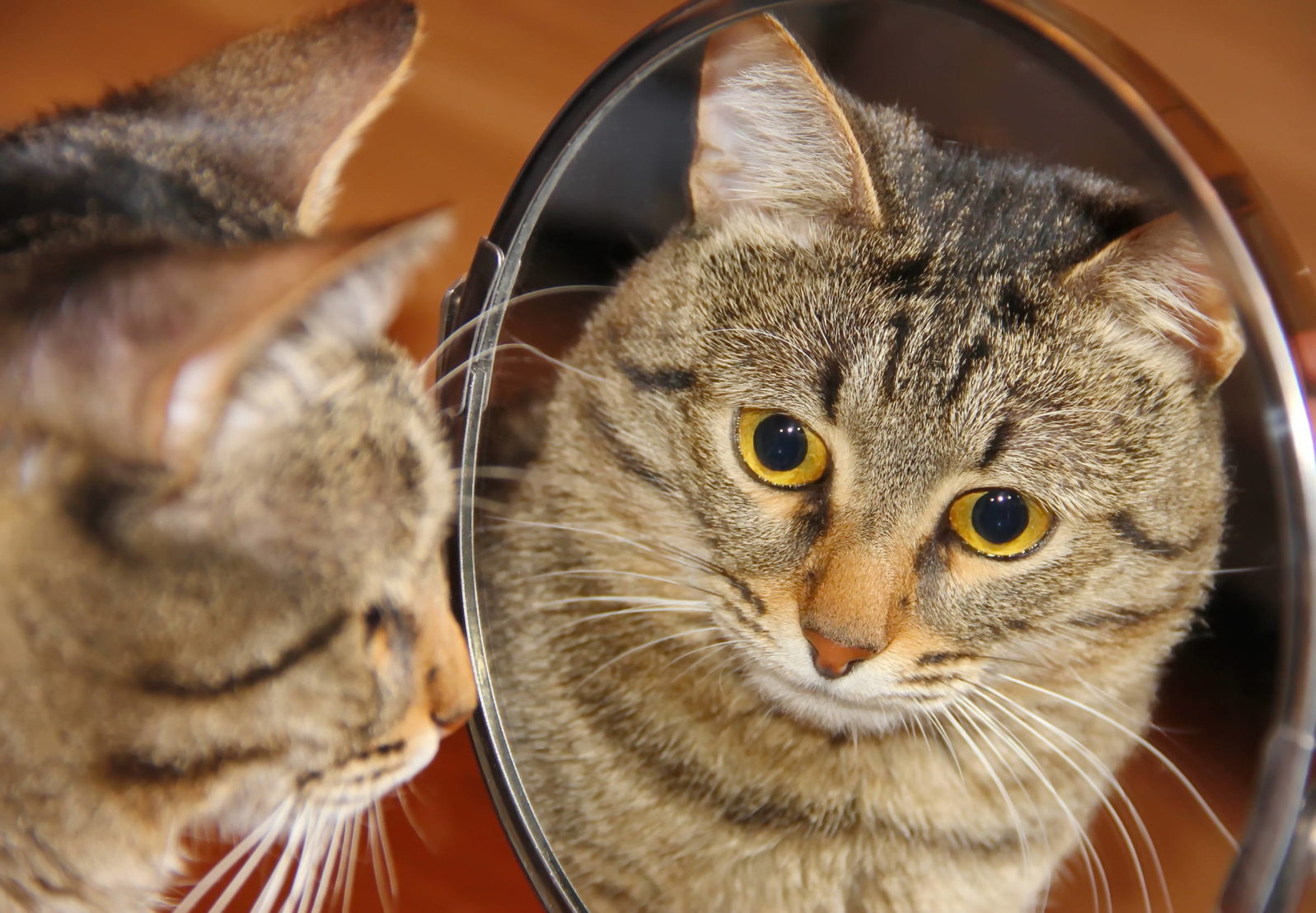Mirror, Mirror, Am I a Self?
Scientists ponder, how would animals show self-awareness?A controversy in animal psychology centers on whether or not an animal can recognize itself in a mirror. But a number of scientists are beginning to doubt that the mirror test shows animal self-awareness.
Invented by evolutionary psychologist George Gallup in 1970, the test has been tried on a variety of species, including elephants, dolphins, great apes, dogs, cats, birds, fish, and horses, with varying—and disputed—results. Gallup, for example, doesn’t agree with colleagues that dolphins, elephants and European magpies have passed.
Recently, a fish (the cleaner wrasse), not known for self-awareness, passed the test. One of the researchers took the opportunity to say that he doubts that the test really identifies self-awareness:
‘Honestly, the test sucks,’ says Alex Jordan, an evolutionary biologist and principle investigator at the Department of Collective Behaviour at the Max Planck Institute in Germany. Jordan is a co-author of a recent study in PLOS Biology evaluating the behaviours of the cleaner wrasse, a small fish that took the test. Jordan and his colleagues argue that the fish passed the test, but that this doesn’t mean that cleaner wrasses are self-aware. ‘It [the mirror test] may be testing for other things, such as associated learning and conflict resolution. But is it testing for self-awareness?’ Jordan asks. ‘No – that’s a stretch.’
Virginia Morell, “What do mirror tests test?” at Aeon
Science writer Virginia Morell offers a useful distinction:
Self-awareness is not, however, the same as being conscious – which is commonly defined as being aware of one’s body and surrounding environment, a mental trait many animals share with us. Indeed in 2012, a prominent international group of neuroscientists, ethologists and psychologists issued what’s been called ‘Cambridge Declaration on Consciousness’. It asserted that
“Convergent evidence indicates that nonhuman animals have the neuroanatomical, neurochemical and neurophysiological substrates of conscious states along with the capacity to exhibit intentional behaviours. Consequently, the weight of evidence indicates that humans are not unique in possessing the neurological substrates that generate consciousness. Nonhuman animals, including all mammals and birds, and many other creatures, including octopuses, also possess these neurological substrates.”
But being conscious of one’s body does not mean that an animal also has a capacity for introspection – a key part of being self-aware. While consciousness is being aware of one’s body, self-awareness takes the sensation one step further – you recognise that you are aware of your awareness.
Virginia Morell, “What do mirror tests test?” at Aeon
And then there is the question of whether visual identification is important to the animal, as opposed to smell (think dogs). And, with more intelligent animals, it might not even mean the same thing as it would to a human:
Gorillas haven’t passed, perhaps because the test requires looking at oneself directly, and staring is not an acceptable behaviour in gorilla society. Gallup and his colleagues attempted to overcome this problem by supplying captive gorillas with special angled mirrors, but the animals still did not pass the test.
Virginia Morell, “What do mirror tests test?” at Aeon
Possibly, gorillas teach themselves not to look too closely, so as to avoid deadly assaults from peers?
Overall, the controversy appears to be founded on a mistake, the assumption that identifying and using one’s image in a mirror is proof of a human type of self-awareness. Surely we have it backward. We humans identify ourselves because we are self-aware. But life forms like the cleaner wrasse could identify their own images without self-awareness if that ability played a role in navigating their environment.
Perhaps the question of whether dolphins (or great apes) pass or fail the mirror test should not be taken as evidence one way or the other about their self-awareness. Both species appear to have a sense of self; they perceive pain or pleasure, for example, as happening to them individually.
Unfortunately, doomed celebrity science efforts to teach human language to dolphins and apes confounds realism about their abilities. Many analysts resist the idea that these animals think but can’t think like humans because they lack the ability to use reason. They can and do, of course, feel emotion.

Other recent controversies about animal minds are founded on similar mistakes. For example, there was a mild flurry in science media when it turned out that cats do recognize their names Some analysts seem to have assumed that, to recognize their names, cats must be able to think like people. But, as Michael Egnor points out, cats recognize their names as a signal, not an abstraction. The cat learns that the sound (Tabby!, perhaps) means that something specific and concrete is likely to happen to him soon. He does not associate the sound with abstract ideas about himself or anything else.
Another mild flurry erupted on the discovery that cats do bond with people. In a study noted in Nature, both cats and kittens showed about the same level of attachment to caregivers as children and dogs did. But why should that be surprising? Instead of attributing an abstract (“cool, uncaring”) attitude to the cat, we might well ask, what is his relationship with people anyway? He comes to them as a recently weaned kitten and, it is hoped, they look after his needs thereafter. Because he does not have a large stock of ideas about how to understand his situation, he simply transfers his attachment from his mother to the human caregivers—and doesn’t think any more about it at all. He certainly does not say to himself, “But wait. I am a cat and these are people!” Those are abstract ideas, unlike the food, warmth, and protection he can feel and respond to.
If turtles, for example, do not bond with people, we might well ask, do they bond with other turtles? Is there a pattern that a turtle follows, left to itself? Could a human replicate that pattern, for whatever bonding can occur? This approach might be more useful than drawing conclusions about intelligence or mental activity as such.
The only disadvantage of such an approach is that it does not demonstrate that humans are just another animal. Maybe that is the price we must pay for greater wisdom and understanding.
Articles on animal minds that may interest you, from Mind Matters News:
Did a fish just show self-awareness? What if the whole question is founded on a mistake about the nature of the mirror test?
The real reason why only human beings speak. Language is a tool for abstract thinking—a necessary tool for abstraction—and humans are the only animals who think abstractly
and
What do animal studies tell us about human minds? They show that human experience is unique.
